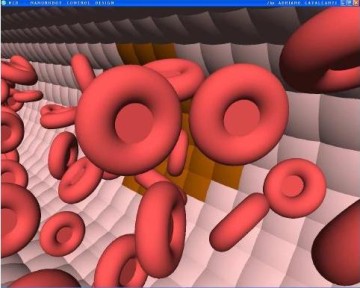Nanorobots to improve health care

Using nanorobots to deliver drugs and fight diseases is not a new idea (check here or there). Of course, nanorobots floating inside our bodies to improve our health are still years away. However, an international team of American and Australian researchers is developing a nanorobot hardware architecture for medical defense (PDF format, 1.02 MB). They have developed a nanorobot control design (NCD) software which helps them to simulate the behavior of these future nanorobots. Their 3-D approach shows 'how nanorobots can effectively improve health care and medical defense and should enable innovative real time protection against pandemic outbreaks.' But read more...

Let's start with an example, when the influenza virus start to invade cells. The NCD software shows how "the bloodstream flows through the vessel in the 3D model. The vessel endothelial cells denote in brown color the influenza virus beginning to spread from one cell to another." (Credit: Cavalcanti et al.)
This second illustration shows "nanorobots detecting higher concentrations of alpha-NAGA signals within the bloodstream." (Credit: Cavalcanti et al.) [Note: "alpha-Nacetylgalactosaminidase (alpha-NAGA) is a protein identified through the genome mapping, which belongs to chromosome 22."]
The images above have been created by Adriano Cavalcanti, the CEO and chairman of the Center for Automation in Nanobiotech (CAN), who also is researcher at Monash University in Melbourne. But he was not alone. He worked with Bijan Shirinzadeh, an associate professor in the Robotics and Mechatronics Research Laboratory at Monash University in Melbourne, Mingjun Zhang, an associate professor of biomedical engineering at the University of Tennessee, Knoxville, TN, and Luiz Carlos Kretly, professor of electronics at the State University of Campinas, Brazil.
This latest research work has been accepted by Sensors, an open-access scientific journal published monthly by the Molecular Diversity Preservation International (MDPI), Basel, Switzerland. Here is a link to this technical paper, "Nanorobot Hardware Architecture for Medical Defense" (Volume 8, Issue 5, Pages 2932-2958, May 2008) (PDF format, 27 pages, 1.02 MB) from which the above illustrations have been extracted.
Here is the beginning of the abstract. "This work presents a new approach with details on the integrated platform and hardware architecture for nanorobots application in epidemic control, which should enable real time in vivo prognosis of biohazard infection. The recent developments in the field of nanoelectronics, with transducers progressively shrinking down to smaller sizes through nanotechnology and carbon nanotubes, are expected to result in innovative biomedical instrumentation possibilities, with new therapies and efficient diagnosis methodologies. The use of integrated systems, smart biosensors, and programmable nanodevices are advancing nanoelectronics, enabling the progressive research and development of molecular machines."
This is the beginning of the conclusions. "This work used a 3D approach to show how nanorobots can effectively improve health care and medical defense. Nanorobots should enable innovative real time protection against pandemic outbreaks. The use of nanomechatronics techniques and computational nanotechnology can help in the process of transducers investigation and in defining strategies to integrate nanorobot capabilities. A better comprehension about the requirements a nanorobot should address, in order to be successfully used for in vivo instrumentation, is a key issue for the fast development of medical nanorobotics."
And here is how nanorobots could be used in fields such as medicine and defense technology to lead us towards a safer future. "The use of nanorobots for in vivo monitoring chemical parameters should significantly increase fast strategic decisions. Thus, nanorobot for medical defense means an effective way to avoid an aggressive pandemic disease to spread into an outbreak. As a direct impact, it should also help public health sectors to save lives and decrease high medical costs, enabling a real time quarantine action."
Before the arrival of real nanorobots, you need to simulate them. This is the goal of nanorobot prototyping software. A March 2008 article of Medical Product Manufacturing News (MPMN), "Software Provides Peek into the Body -- and the Future" describes the nanorobot control design (NCD) software, "a system designed to serve as a test bed for nanorobot 3-D prototyping." .
So what is exactly this NCD platform? It "combines 3-D modeling and virtual reality to enable the design, simulation, and testing of nanorobots. In a real-time simulation demonstration, virtual nanorobots were assigned the task of searching for proteins in a dynamic environment, and bringing those proteins to a specific organ inlet for drug delivery. Simulation using 3-D modeling can provide interactive tools for analyzing nanorobot design choices, including decisions related to sensors, architectural design, manufacturing, and control methodology. Specifically, NCD lets nanorobots operate inside of a virtual human body in order to compare control techniques."
Cavalcanti says that "designers will be able to use the NCD platform for actual nanorobot design prototyping for specific applications." He also says that "achieving the goal of functional, feasible nanorobots will be a three-step process. First, model manufacturing with carbon nanotube-CMOS biochip integration will have to occur, followed by in vivo tests, and, finally, commercialization."
[Disclaimer: I have no financial ties with Adriano Cavalcanti and his company. For more information -- and pictures -- about his research, please check his Nanorobotics Control Design site.]
Sources: Sensors, May 2008; Medical Product Manufacturing News (MPMN), March 2008; and various websites
You'll find related stories by following the links below.